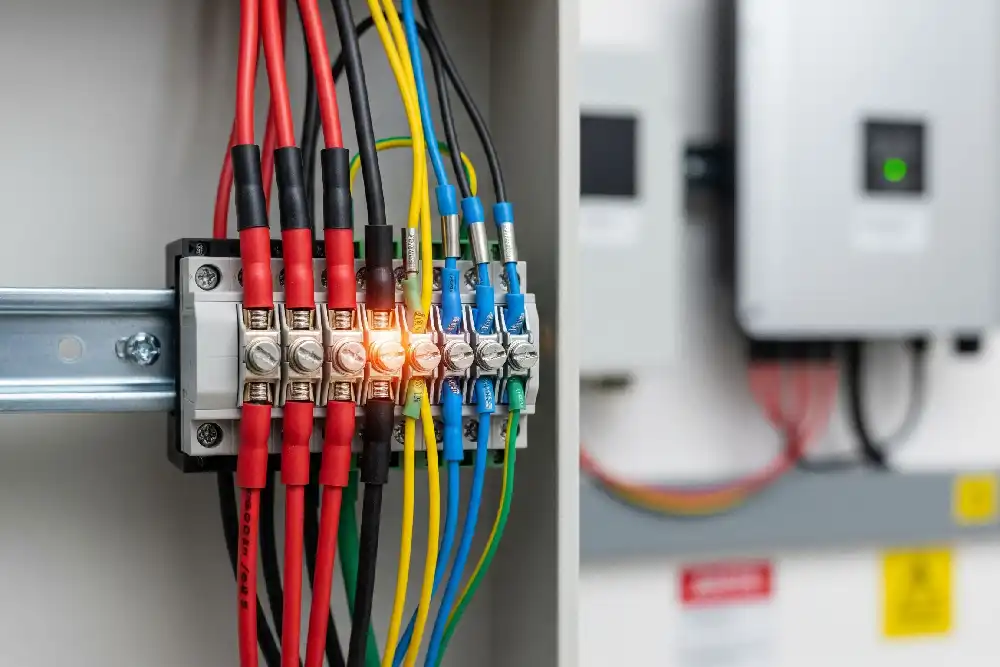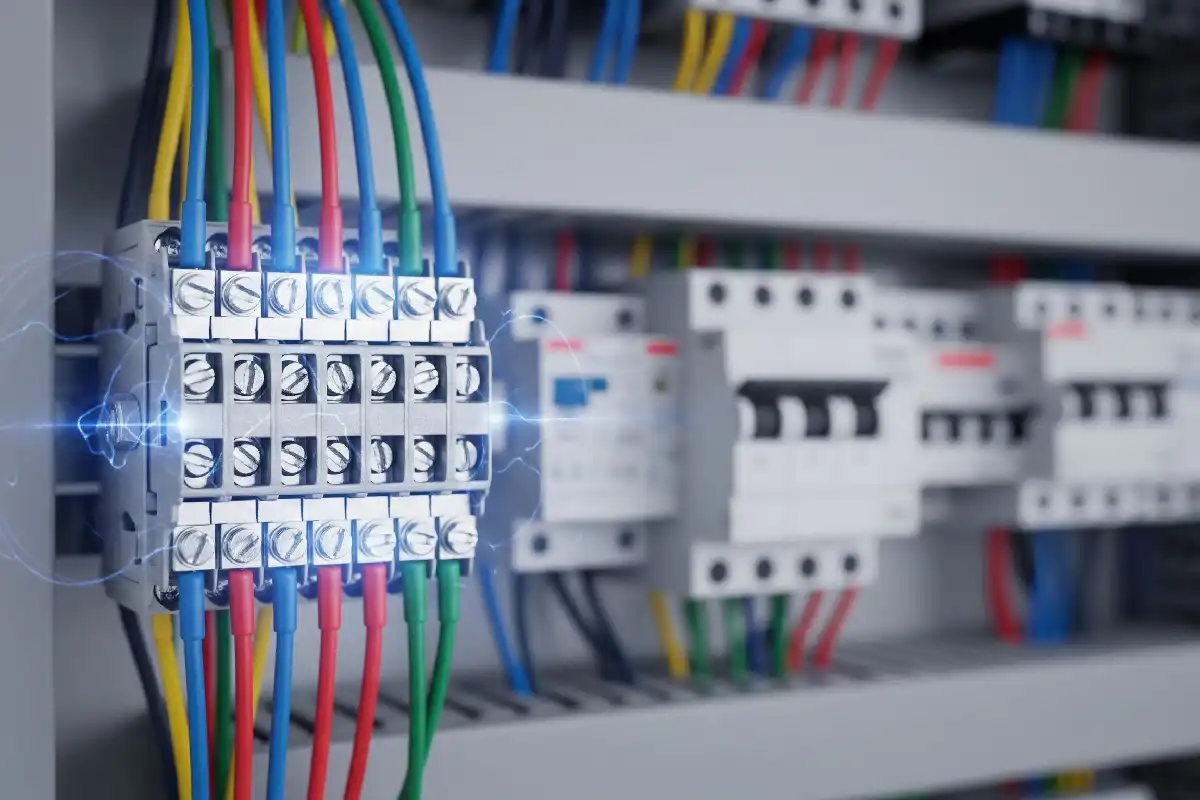If you want to connect wires in your solar setup, you need the right terminal blocks. Go for compression, lever, or quick-connect types rated for DC and solar use. Always pick Solar system terminal blocks with a current rating at least 50% higher than what you expect.
Make sure the block fits your wire size and handles the weather where you install it. This helps your solar system stay safe and reliable.
Key Takeaways
- Pick terminal blocks made for DC and solar systems. Make sure the current rating is 50% higher than your system’s top current.
- Use compression or lever terminal blocks for easy setup. These types make strong connections and need no special tools.
- Match terminal blocks to your wire’s size and type. Using the wrong size can cause loose connections, overheating, or fires.
- Find terminal blocks with UV and moisture resistance for outdoor use. This keeps your system safe from weather and helps it last longer.
- Always look for safety certifications like UL or IEC. Certified blocks help stop electrical problems and keep things safe.
Solar System Terminal Blocks
When you build a solar system, you need to pick the right terminal blocks. There are a few main types, and each one has its own good points.
Compression and Lever Types
Compression and lever terminal blocks make wiring simple. You push or flip a lever to lock the wire in. These are used a lot in solar panel junction boxes. You can put them in fast and do not need special tools. They give a strong connection that does not come loose with shaking or heat. Some, like ZK-PV, are made for solar and work well with high DC voltages. If you want something easy and safe, these blocks are a smart pick.
Tip: Lever and compression blocks help stop loose wires. Loose wires can get hot and hurt your solar system.
Screw and Spring-Cage Types
Screw terminal blocks use a screw to hold the wire tight. They are strong and good if you need to connect more than one wire. Spring-cage types use a spring to grip the wire. They have low resistance and make a good connection. But springs can get weak if your system gets hot a lot. In crowded setups, spring terminals can jam or be hard to use. Screw types are easier to use again and again.
- Spring terminals can get weak with heat and may fail.
- Screw terminals are better when you have many wires.
Feed-Through and Multi-Conductor Blocks
Feed-through terminal blocks let you connect wires on both sides. They are great for combiner boxes or joining many strings. Multi-conductor blocks let you connect more than two wires in one spot. This keeps your wires neat and tidy. Many Solar system terminal blocks like these are made for outdoor use and can handle sun and rain.
If you want your system to last, always choose Solar system terminal blocks made for photovoltaic use. Look for ones that protect against water, sun, and heat. This helps you avoid problems like loose wires, burnt parts, or weather damage.
Key Specifications
Current and Voltage Ratings
When you pick terminal blocks for your solar setup, always check the current and voltage ratings first. You want a block that can handle more than your system needs. A good rule is to choose a current rating at least 50% higher than your highest expected current. This helps prevent overheating and keeps your system safe. Make sure the terminal block is rated for DC voltage, not just AC. Some blocks pass a partial discharge test, which means they work well with high DC voltages and help stop electrical leaks. If you use Solar system terminal blocks with the right ratings, your connections will last longer and work better.
Wire Size and Type
You need to match the terminal block to your wire size and type. If the wire is too big or too small for the block, you might get a loose connection. Loose wires can cause heat and even fires. Always check the wire gauge range on the terminal block label. Some blocks work with solid wires, while others fit stranded wires better. Pick the right type for your cables. This step keeps your system safe and helps it run smoothly.
Environmental Resistance
Outdoor solar systems face sun, rain, and changing weather. Your terminal blocks must stand up to these conditions. Look for blocks with UV and moisture resistance. These features help your system last longer and work better in tough weather. Here’s a quick look at what to check:
| Feature | Description |
|---|---|
| Moisture Resistance | Blocks keep water out, stopping electrical damage. |
| UV Resistance | UV-stable materials stop sunlight from breaking down the block. |
| System Reliability | Waterproof blocks lower the risk of connection problems. |
| System Durability | UV resistance helps blocks last longer outdoors. |
| Performance Efficiency | Good connections keep your system working well in any weather. |
If you choose terminal blocks with these protections, your solar system will stay reliable and safe for years.
Choosing Terminal Blocks
Assessing System Needs
You need to start by looking at your solar system’s size and layout. What is your system’s maximum current and voltage? Write these numbers down. Check how many wires you need to connect and where you plan to put the terminal blocks. If you have a big system, you may need more blocks or larger ones. Small systems can use compact blocks. Always match the block’s rating to your system’s needs.
Tip: Pick terminal blocks with a current rating at least 50% higher than your system’s highest current. This keeps your setup safe.
Ask yourself:
- What is the highest current my system will carry?
- What is the highest voltage my system will reach?
- How many wires do I need to connect?
- Where will I install the blocks (indoors or outdoors)?
If you answer these questions, you will know what type and size of terminal block to buy.
Application Areas (Combiner Box, Inverter, Battery)
You will find terminal blocks in different parts of your solar system. Each area needs a certain type of block.
Combiner Box:
This box joins wires from several solar panels. You need terminal blocks that can handle many wires at once. Feed-through or multi-conductor blocks work well here. They keep wires neat and make it easy to add or remove panels.
Inverter:
The inverter changes DC power to AC power. You need blocks that can handle high current and voltage. Use blocks rated for DC and AC if possible. Compression or screw types are common here.
Battery Bank:
Batteries store your solar power. You need strong connections that do not come loose. Lever or compression blocks are a good choice. They make it easy to disconnect for maintenance.
Here’s a quick table to help you choose:
| Area | What to Use | Why It Works |
|---|---|---|
| Combiner Box | Feed-through, Multi-conductor | Handles many wires, keeps order |
| Inverter | Compression, Screw | Handles high current and voltage |
| Battery Bank | Lever, Compression | Easy to connect/disconnect, strong |
Installation and Maintenance
You want your solar system to be easy to install and maintain. Tool-free terminal blocks, like lever or compression types, save you time. You just push or flip a lever to connect wires. No screwdriver needed! This makes it simple to check or change wires later.
Note: Always double-check that wires are tight and secure. Loose wires can cause heat and damage.
Here are some tips for easy installation and care:
- Use tool-free blocks if you want fast setup.
- Label each wire and block for easy tracking.
- Check connections every few months.
- Replace any block that looks damaged or worn.
If you choose the right Solar system terminal blocks, you make your system safer and easier to manage. Good planning now saves you trouble later.
Safety and Standards
Certifications
When you pick terminal blocks, look for certifications. These show the blocks are safe for solar use. You need blocks tested for high DC voltage. They should also work well outdoors. UL and IEC are important groups. They check if blocks can handle sunlight, water, and electrical stress.
Here’s a table with some main certification standards for solar terminal blocks:
| Certification Standard | Description |
|---|---|
| UL 854 | Service-Entrance Cables |
| UL 4703 | PV wire, sunlight resistance |
| UL 9703 | Distributed Generation Wiring Harnesses |
| UL 3730 | Photovoltaic Junction Boxes |
| UL 6703 | Connectors for Photovoltaic Systems |
If you see these certifications, the block follows strict safety rules. IEC standards also help your blocks work well in solar systems. Always look for these marks before you buy.
Tip: Certified blocks help stop electrical leaks and fire risks.
Installation Best Practices
You want your solar system to be safe for years. Good installation helps you avoid loose wires and overheating. It also stops short circuits. Always follow these best steps:
- Use blocks with the right current and voltage ratings.
- Match the block to your wire size and type.
- Pick blocks with UV and moisture resistance for outside use.
- Make sure every wire is tight and secure.
- Label each wire and block for easy checks later.
Mistakes can hurt your system. Here are things to watch out for:
- Using blocks without the right certifications.
- Connecting wires that do not fit the block.
- Leaving wires loose or not pushed in all the way.
- Not using weather protection for outdoor blocks.
- Forgetting to check connections after you install them.
Note: Safe installation keeps your solar system working and protects your home.
If you follow these standards and steps, your solar setup will be safer and more reliable.
When you choose terminal blocks, check the current rating. Make sure they work with DC power. Install them the right way. Pick a block that fits your wire size. Look for safety certifications on the block. These steps help keep your solar system safe:
| Safety Practice | Importance |
|---|---|
| Use certified equipment | Lowers risk of faults |
| Hire licensed installers | Cuts down on mistakes |
| Ground and bond your system | Prevents shocks |
| Inspect and maintain regularly | Spots hazards early |
If your system is hard to figure out, read the datasheet. You can also ask a professional for help.
FAQ
What terminal block should you use for outdoor solar panels?
You should pick terminal blocks with UV and moisture resistance. Look for blocks labeled for outdoor or photovoltaic use. These blocks last longer in sun and rain.
What happens if you use the wrong wire size in a terminal block?
If you use the wrong wire size, you might get a loose connection. Loose wires can overheat or even cause a fire. Always match the wire size to the block’s range.
What certifications matter for solar terminal blocks?
You want terminal blocks with UL or IEC certifications. These show the blocks passed safety tests for solar systems. Certified blocks help protect your system from electrical problems.
What is the easiest terminal block to install?
Lever and compression terminal blocks are the easiest. You just push or flip a lever to connect wires. No tools needed! This makes installation quick and simple.
See also
Top 7 Terminal Block Brands Every Engineer Should Consider
Quick Guide to Common Terminal Blocks in Industrial Automation
How to Pick the Ideal Terminal Block for Your Project
Why Choose Customized Terminal Blocks for Unique Electrical Needs




